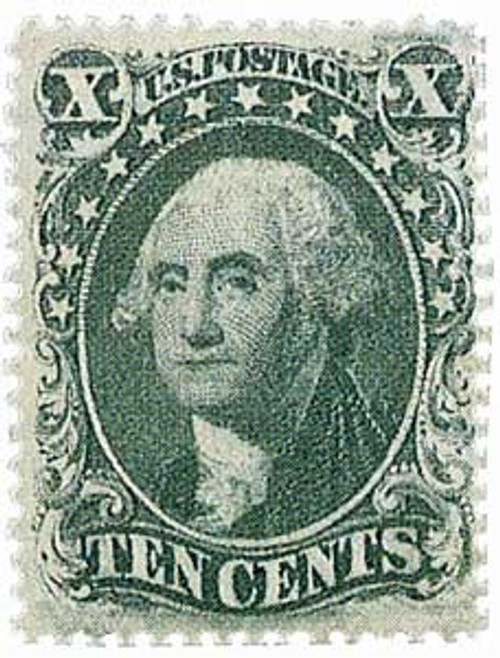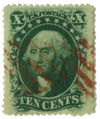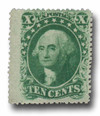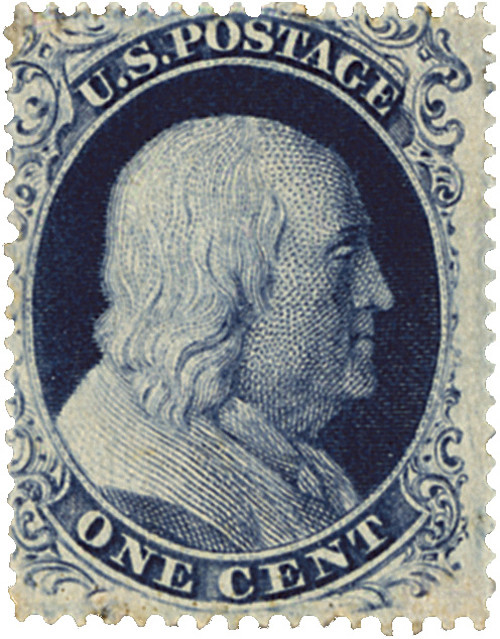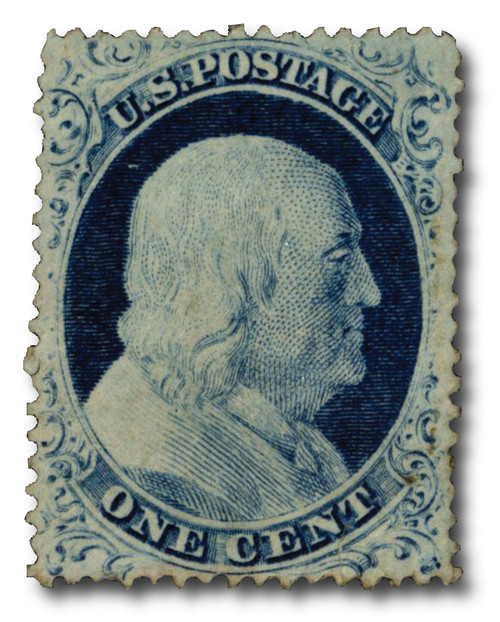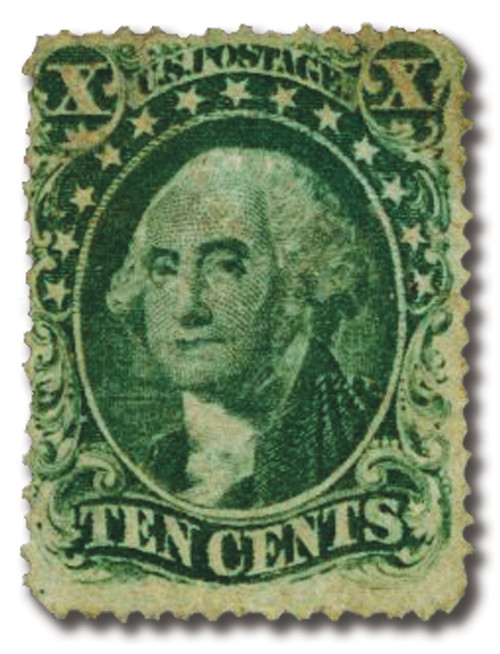
# 35 - 1859 10c Washington, green, type V
U.S. #35
1857 Washington, Type IV
- Part of the first perforated series of US stamps
- Paid the domestic rate between the eastern states and California
Stamp Category: Definitive
Series: 1857-61 Issue
Value: 10c
Earliest Documented Use: April 29, 1859
Printed by: Toppan, Carpenter & Co.
Quantity printed: 10,000,000 (estimate)
Format: Printed in sheets of 200 stamps, divided into vertical panes of 100 each
Printing Method: Engraving
Perforations: 15½
Color: Green
Why the stamp was issued: The Act of April, 1855 increased the rate for any domestic letter weighing up to one-half ounce and sent over 3000 miles from six to ten cents. The rate increase helped pay for the cost of building railroads and transporting the mail such a great distance across the continent. Many of the stamps were used to frank letters going and from to California. Like the imperforate 10c stamps of the previous series (#13-16) the new perforated 10c stamp satisfied the new rate.
About the printing: The design is engraved on a die – a small, flat piece of steel. The design is copied to a transfer roll – a blank roll of steel. Several impressions or “reliefs” are made on the roll. The reliefs are transferred to the plate – a large, flat piece of steel from which the stamps are printed.
Types or “varieties” occur when a stamp has differences which vary from the way it was originally engraved. Foreign matter, or damage to or recutting of the plate for any reason, can cause these differences to appear on the stamps printed from it. There were five types created by changes to the printing plates of the 10c Washington.
About the design: The image of George Washington on #35 is based on a painting by Gilbert Stuart, who painted many portraits of the first president. Thirteen white stars, symbolizing the 13 original US colonies, form an arch over Washington’s head in the stamp’s medallion.
Special Design Details: US #35 is a Type V. (Type V isn’t found in the 1851-57 imperforate series of the same design.) Usually only one pearl appears on both sides, although there may be more on either. The side ornaments are incomplete.
About the 1857-61 Series: In July, 1851 – 1c, 3c, and 12c stamps were issued. The new stamps met reduced postal rates passed by act of Congress on March 3 of the same year. Further changes in postage rates appeared in the Act of March 3, 1855, leading to 10c (1855) and 5c (1856) denominations being added to the series. Perforated stamps of the same designs as the 1851-57 Imperforate Series (plus new denominations of 24c, 30c, and 90c) were issued as part of the Series of 1857-61, the first perforated U.S. stamps.
The new series’ designs were reproduced from the imperforate plates of 1851. Because the same plates were used, the perforated stamp types don’t differ much from the corresponding imperforate stamps. The entire series (U.S. #18-39) is noted for having narrow margins. This is because the perforations took up room normally given to the designs.
History the stamp represents: #35 was part of the first series of perforated U.S. postage stamps. When the world’s first postage stamps were issued, no provision was made for separating the stamps from one another. Post office clerks and stamp users merely cut these “imperforates” apart with scissors or tore them along the edge of a metal rule. A device was needed which would separate the stamps more easily and accurately.
In 1847, Irishman Henry Archer patented a machine that punched holes horizontally and vertically between rows of stamps. Now stamps could be separated without cutting. Perforations also enabled stamps to adhere better to envelopes. Archer sold his invention to the British Treasury in 1853. That same year, Great Britain produced its first perforated stamps. It wasn’t long before the US decided to make use of the new method of producing stamps with perforations, resulting in the Series of 1857-61.
U.S. #35
1857 Washington, Type IV
- Part of the first perforated series of US stamps
- Paid the domestic rate between the eastern states and California
Stamp Category: Definitive
Series: 1857-61 Issue
Value: 10c
Earliest Documented Use: April 29, 1859
Printed by: Toppan, Carpenter & Co.
Quantity printed: 10,000,000 (estimate)
Format: Printed in sheets of 200 stamps, divided into vertical panes of 100 each
Printing Method: Engraving
Perforations: 15½
Color: Green
Why the stamp was issued: The Act of April, 1855 increased the rate for any domestic letter weighing up to one-half ounce and sent over 3000 miles from six to ten cents. The rate increase helped pay for the cost of building railroads and transporting the mail such a great distance across the continent. Many of the stamps were used to frank letters going and from to California. Like the imperforate 10c stamps of the previous series (#13-16) the new perforated 10c stamp satisfied the new rate.
About the printing: The design is engraved on a die – a small, flat piece of steel. The design is copied to a transfer roll – a blank roll of steel. Several impressions or “reliefs” are made on the roll. The reliefs are transferred to the plate – a large, flat piece of steel from which the stamps are printed.
Types or “varieties” occur when a stamp has differences which vary from the way it was originally engraved. Foreign matter, or damage to or recutting of the plate for any reason, can cause these differences to appear on the stamps printed from it. There were five types created by changes to the printing plates of the 10c Washington.
About the design: The image of George Washington on #35 is based on a painting by Gilbert Stuart, who painted many portraits of the first president. Thirteen white stars, symbolizing the 13 original US colonies, form an arch over Washington’s head in the stamp’s medallion.
Special Design Details: US #35 is a Type V. (Type V isn’t found in the 1851-57 imperforate series of the same design.) Usually only one pearl appears on both sides, although there may be more on either. The side ornaments are incomplete.
About the 1857-61 Series: In July, 1851 – 1c, 3c, and 12c stamps were issued. The new stamps met reduced postal rates passed by act of Congress on March 3 of the same year. Further changes in postage rates appeared in the Act of March 3, 1855, leading to 10c (1855) and 5c (1856) denominations being added to the series. Perforated stamps of the same designs as the 1851-57 Imperforate Series (plus new denominations of 24c, 30c, and 90c) were issued as part of the Series of 1857-61, the first perforated U.S. stamps.
The new series’ designs were reproduced from the imperforate plates of 1851. Because the same plates were used, the perforated stamp types don’t differ much from the corresponding imperforate stamps. The entire series (U.S. #18-39) is noted for having narrow margins. This is because the perforations took up room normally given to the designs.
History the stamp represents: #35 was part of the first series of perforated U.S. postage stamps. When the world’s first postage stamps were issued, no provision was made for separating the stamps from one another. Post office clerks and stamp users merely cut these “imperforates” apart with scissors or tore them along the edge of a metal rule. A device was needed which would separate the stamps more easily and accurately.
In 1847, Irishman Henry Archer patented a machine that punched holes horizontally and vertically between rows of stamps. Now stamps could be separated without cutting. Perforations also enabled stamps to adhere better to envelopes. Archer sold his invention to the British Treasury in 1853. That same year, Great Britain produced its first perforated stamps. It wasn’t long before the US decided to make use of the new method of producing stamps with perforations, resulting in the Series of 1857-61.

